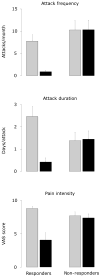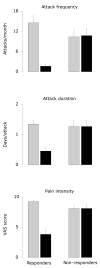Exploding vs. imploding headache in migraine prophylaxis with Botulinum Toxin A
- PMID: 17069972
- PMCID: PMC1831831
- DOI: 10.1016/j.pain.2006.09.012
Exploding vs. imploding headache in migraine prophylaxis with Botulinum Toxin A
Abstract
Migraine headache is routinely managed using medications that abort attacks as they occur. An alternative approach to migraine management is based on prophylactic medications that reduce attack frequency. One approach has been based on local intramuscular injections of Botulinum Toxin Type A (BTX-A). Here, we explored for neurological markers that might distinguish migraine patients who benefit from BTX-A treatment (100 units divided into 21 injections sites across pericranial and neck muscles). Responders and non-responders to BTX-A treatment were compared prospectively (n=27) and retrospectively (n=36) for a host of neurological symptoms associated with their migraine. Data pooled from all 63 patients are summarized below. The number of migraine days per month dropped from 16.0+/-1.7 before BTX-A to 0.8+/-0.3 after BTX-A (down 95.3+/-1.0%) in 39 responders, and remained unchanged (11.3+/-1.9 vs. 11.7+/-1.8) in 24 non-responders. The prevalence of aura, photophobia, phonophobia, osmophobia, nausea, and throbbing was similar between responders and non-responders. However, the two groups offered different accounts of their pain. Among non-responders, 92% described a buildup of pressure inside their head (exploding headache). Among responders, 74% perceived their head to be crushed, clamped or stubbed by external forces (imploding headache), and 13% attested to an eye-popping pain (ocular headache). The finding that exploding headache was impervious to extracranial BTX-A injections is consistent with the prevailing view that migraine pain is mediated by intracranial innervation. The amenability of imploding and ocular headaches to BTX-A treatment suggests that these types of migraine pain involve extracranial innervation as well.
Figures





Comment in
-
Squeezing life into botulinum toxin A in migraine: imploding versus exploding pain.Pain. 2006 Dec 5;125(3):206-207. doi: 10.1016/j.pain.2006.10.001. Epub 2006 Oct 25. Pain. 2006. PMID: 17069974 No abstract available.
-
Exploding vs. imploding headache in migraine prophylaxis with Botulinum Toxin A.Pain. 2007 Jun;129(3):363-364. doi: 10.1016/j.pain.2007.02.002. Epub 2007 Mar 13. Pain. 2007. PMID: 17360120 No abstract available.
References
-
- Aoki KR. Review of a proposed mechanism for the antinociceptive action of botulinum toxin type A. Neurotoxicology. 2005;26:785–93. - PubMed
-
- Berweck S, Heinen F. Use of botulinum toxin in pediatric spasticity (cerebral palsy) Mov Disord. 2004;19:S162–7. Suppl 8. - PubMed
-
- Binder WJ, Brin MF, Blitzer A, Schoenrock LD, Pogoda JM. Botulinum toxin type A (BOTOX) for treatment of migraine headaches: an open-label study. Otolaryngol Head Neck Surg. 2000;123:669–76. - PubMed
Publication types
MeSH terms
Substances
Grants and funding
LinkOut - more resources
Full Text Sources
Other Literature Sources
Medical
Miscellaneous

